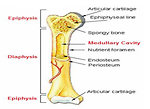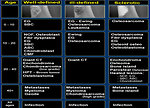Special section Bone tumors
Introduction
The human skeleton consists of 206 bones. When put together, the skeletal system provides the base framework to which all the other tissues and organs attach, giving shape to the human body. The human skeleton has two distinct features, including opposable thumbs and an erect structure, allowing us to walk on two legs.
The skeletal system is divided into two parts -- the axial skeleton (spine, ribs, skull and sternum), and the appendicular skeleton (pelvis, arm and leg bones). The skeleton has five main functions.
Functions of the skeleton (Figure 1):
- Shape: body shape or type is genetically inherited. There are three main body shapes -- ectomorphs (tall and thin), mesomorphs (shorter and muscular) and endomorphs (apple or pear-shaped).
- Support and protection the skeleton provides support to the body and protect our vital organs (skull, sternum, ribs, pelvis)
- Movement: the muscular and skeletal systems work together to carry out bodily movement, and together they are called the musculoskeletal system.
- Blood cell production: bone marrow contains blood forming cell is vital for hematopoiesis (Figure 2)
- Storage and metabolic function of the bones (calcium-phosphate metabolism)
Bone tumors
There is a broad spectrum of bone tumors (benign and malignant) as well as other non-neoplastic lesions (inflammatory, vascular, etc.) (Figure 3).
Type of lesion, localization, character (osteolytic, sclerotic or mixed) is age-dependent (Figure 4).
Many types of cancer that start in other organs of the body can spread to the bones and lead to metastatic bone disease. In pediatric age the most common type of cancer metastases to the skeleton is neuroblastoma, rhabdomyosarcoma, clear cell sarcoma of the kidney and primary bone tumors also can develop multiple bone metastases.
Primary bone tumors are the 6th most frequent cancer in children < 15 years (5% of all malignancies) and the 3rd most frequent tumor in adolescent age (15–21 years).
Annual incidence of bone tumors is 8.7 : 1 million(USA).
Two types of primary bone tumors dominate in pediatric and adolescent oncology:
 Figure 1: Functions of the skeleton |
 Figure 2: Bone anatomy |
 Figure 3: Types of bone tumors and lesions |
 Figure 4: Morphology of bone lesions depending on the age |
||||
